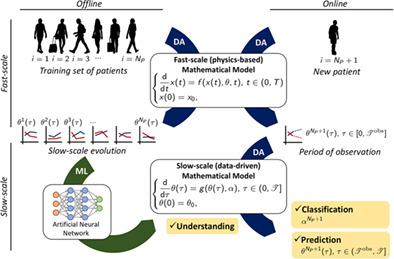当前位置:
X-MOL 学术
›
Int. J. Numer. Method. Biomed. Eng.
›
论文详情
Our official English website, www.x-mol.net, welcomes your feedback! (Note: you will need to create a separate account there.)
Combining data assimilation and machine learning to build data-driven models for unknown long time dynamics—Applications in cardiovascular modeling
International Journal for Numerical Methods in Biomedical Engineering ( IF 2.1 ) Pub Date : 2021-04-29 , DOI: 10.1002/cnm.3471 Francesco Regazzoni 1, 2, 3 , Dominique Chapelle 2, 3 , Philippe Moireau 2, 3
International Journal for Numerical Methods in Biomedical Engineering ( IF 2.1 ) Pub Date : 2021-04-29 , DOI: 10.1002/cnm.3471 Francesco Regazzoni 1, 2, 3 , Dominique Chapelle 2, 3 , Philippe Moireau 2, 3
Affiliation

|
We propose a method to discover differential equations describing the long-term dynamics of phenomena featuring a multiscale behavior in time, starting from measurements taken at the fast-scale. Our methodology is based on a synergetic combination of data assimilation (DA), used to estimate the parameters associated with the known fast-scale dynamics, and machine learning (ML), used to infer the laws underlying the slow-scale dynamics. Specifically, by exploiting the scale separation between the fast and the slow dynamics, we propose a decoupling of time scales that allows to drastically lower the computational burden. Then, we propose a ML algorithm that learns a parametric mathematical model from a collection of time series coming from the phenomenon to be modeled. Moreover, we study the interpretability of the data-driven models obtained within the black-box learning framework proposed in this paper. In particular, we show that every model can be rewritten in infinitely many different equivalent ways, thus making intrinsically ill-posed the problem of learning a parametric differential equation starting from time series. Hence, we propose a strategy that allows to select a unique representative model in each equivalence class, thus enhancing the interpretability of the results. We demonstrate the effectiveness and noise-robustness of the proposed methods through several test cases, in which we reconstruct several differential models starting from time series generated through the models themselves. Finally, we show the results obtained for a test case in the cardiovascular modeling context, which sheds light on a promising field of application of the proposed methods.
中文翻译:

结合数据同化和机器学习,为未知的长时间动态建立数据驱动模型——在心血管建模中的应用
我们提出了一种发现微分方程的方法,该微分方程描述了具有多尺度行为特征的现象的长期动态,从快速尺度的测量开始。我们的方法基于数据同化 (DA) 的协同组合,用于估计与已知快速尺度动力学相关的参数,以及机器学习 (ML),用于推断慢尺度动力学背后的规律。具体来说,通过利用快慢动态之间的尺度分离,我们提出了时间尺度的解耦,从而大大降低了计算负担。然后,我们提出了一种 ML 算法,该算法从来自要建模的现象的时间序列集合中学习参数化数学模型。而且,我们研究了在本文提出的黑盒学习框架内获得的数据驱动模型的可解释性。特别是,我们表明每个模型都可以以无限多种不同的等效方式重写,从而使从时间序列开始学习参数微分方程的问题本质上是不合适的。因此,我们提出了一种策略,允许在每个等价类中选择唯一的代表性模型,从而增强结果的可解释性。我们通过几个测试用例证明了所提出方法的有效性和噪声鲁棒性,其中我们从通过模型本身生成的时间序列开始重建了几个差分模型。最后,我们展示了在心血管建模背景下的测试用例获得的结果,
更新日期:2021-04-29
中文翻译:

结合数据同化和机器学习,为未知的长时间动态建立数据驱动模型——在心血管建模中的应用
我们提出了一种发现微分方程的方法,该微分方程描述了具有多尺度行为特征的现象的长期动态,从快速尺度的测量开始。我们的方法基于数据同化 (DA) 的协同组合,用于估计与已知快速尺度动力学相关的参数,以及机器学习 (ML),用于推断慢尺度动力学背后的规律。具体来说,通过利用快慢动态之间的尺度分离,我们提出了时间尺度的解耦,从而大大降低了计算负担。然后,我们提出了一种 ML 算法,该算法从来自要建模的现象的时间序列集合中学习参数化数学模型。而且,我们研究了在本文提出的黑盒学习框架内获得的数据驱动模型的可解释性。特别是,我们表明每个模型都可以以无限多种不同的等效方式重写,从而使从时间序列开始学习参数微分方程的问题本质上是不合适的。因此,我们提出了一种策略,允许在每个等价类中选择唯一的代表性模型,从而增强结果的可解释性。我们通过几个测试用例证明了所提出方法的有效性和噪声鲁棒性,其中我们从通过模型本身生成的时间序列开始重建了几个差分模型。最后,我们展示了在心血管建模背景下的测试用例获得的结果,



























 京公网安备 11010802027423号
京公网安备 11010802027423号